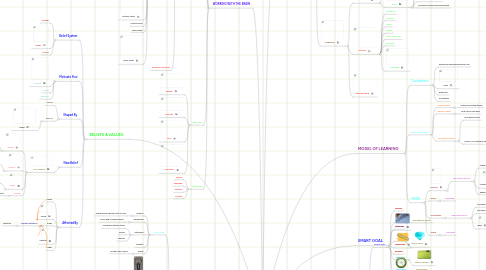
1. MOON KIAN
1.1. Learn Chinese Knotting
1.1.1. SMART Goal
1.1.1.1. Specific
1.1.1.1.1. Teach simple Chinese Knot to class
1.1.1.2. Measurable
1.1.1.2.1. According to Learning Plan
1.1.1.3. Attainable
1.1.1.3.1. Chinese Knotting Strings
1.1.1.3.2. Books
1.1.1.3.3. Internet
1.1.1.4. Realistic
1.1.1.5. Timely
1.1.1.5.1. By the end of GEMs
1.1.2. Simple
1.1.2.1. Monkey Fist Knot
1.1.2.2. Flower Knot
1.1.3. Difficult
1.1.3.1. Flower Knot
1.1.3.2. Butterfly Knot
1.1.3.3. Angel Knot
1.2. About Me
1.2.1. Personality
1.2.1.1. Talkative
1.2.1.2. Friendly
1.2.1.3. Outgoing
1.2.2. Interest
1.2.2.1. Loves
1.2.2.1.1. Her
1.2.2.1.2. Eating
1.2.2.1.3. Shopping
1.2.2.1.4. Mahjong
1.2.2.2. Hates
1.2.2.2.1. Hypocrites
1.2.2.2.2. Liars
2. MIND MAP
2.1. Main Idea
2.2. Images
2.3. Colours
2.4. Details
3. BELIEFS & VALUES
3.1. Belief System
3.1.1. Thought
3.1.2. Words
3.1.3. Actions
3.2. Motivate Your
3.2.1. Thinking
3.2.2. Saying
3.2.3. Behaving
3.3. Shaped By
3.3.1. Internal
3.3.2. External
3.3.2.1. Media
3.4. New Belief
3.4.1. Four Seasons
3.4.1.1. Winter
3.4.1.1.1. Belief let go & fade away
3.4.1.2. Autumn
3.4.1.2.1. Belief outdated & withers
3.4.1.3. Spring
3.4.1.3.1. New Seed
3.4.1.4. Summer
3.4.1.4.1. Grow strong & take roots
3.5. Affected By
3.5.1. Taste
3.5.2. Touch
3.5.3. Smell
3.5.3.1. Feeling Experience
3.5.3.1.1. Reaction
3.5.4. Hearing
3.5.5. Sight
4. WORKING WITH THE BRAIN
4.1. Multi-Task
4.1.1. Impossible
4.2. Brain Structure (Cerebral Cortex)
4.2.1. Frontal Lobe
4.2.2. Parietal Lobe
4.2.3. Occipital Lobe
4.2.4. Temporal Lobe
4.3. Intelligence Measurement
4.3.1. Intelligience Quotients
4.3.1.1. Classification Skills
4.3.1.2. Spatial Skills
4.3.1.3. Logical Reasoning
4.3.1.4. Verbal Skills
4.3.1.5. General Knowledge
4.3.2. Multiple Intelligence
4.3.2.1. Self Smart
4.3.2.2. People Smart
4.3.2.3. Word Smart
4.3.2.4. Number Smart
4.3.2.5. Picture Smart
4.3.2.6. Body Smart
4.3.2.7. Music Smart
4.3.3. Emotional Quotients
4.4. Brain Food
4.4.1. Oxygen
4.4.2. Nutrition
4.4.3. Love
4.4.4. Information
4.5. Braintivities
4.5.1. Explore
4.5.2. Challenge
4.5.3. Regroup
4.5.4. Innovate
5. FENG YU
5.1. Learn Phototaking
5.1.1. SMART Goal
5.1.1.1. Specfic
5.1.1.1.1. Take Beautiful Photos
5.1.1.2. Realistic
5.1.1.3. Timely
5.1.1.3.1. End of Gems
5.1.1.4. Attainable
5.1.1.4.1. Camera needed
5.1.1.5. Measurable
5.1.1.5.1. Learning Plan
5.1.2. Through
5.1.2.1. Internet
5.1.2.1.1. Website
5.1.2.1.2. Videos
5.1.2.2. Friends
5.1.2.2.1. Kenneth
5.1.2.3. Books
5.1.2.4. Taking more photos
5.1.2.5. Camera Manual
5.1.3. Photos
5.1.3.1. Colours
5.1.3.2. Images
5.1.3.3. Thoughts & Feeling
5.1.3.4. Details
5.1.3.5. Lighting
5.1.3.6. Composition
5.1.3.7. Memories
5.1.3.8. Angles
5.1.3.8.1. Subjective Angle
5.1.3.8.2. Objective Angle
5.1.3.8.3. Low Angle
5.1.3.8.4. High Angle
5.1.3.8.5. Oblique Angle
6. SMART GOAL
6.1. Specific
6.2. Attainable
6.3. Measurable
6.4. Realistic
6.5. Timely
7. MODEL OF LEARNING
7.1. Competence
7.1.1. Require for performing specific job
7.1.2. Skills
7.1.3. Behaviour
7.1.4. Knowledge
7.2. Creative Leverage
7.2.1. Primary Effect
7.2.1.1. 1st item rmb better/easier
7.2.2. Recency Effect
7.2.2.1. Most recent rmb best
7.2.3. Von Restorff Effect
7.2.3.1. Rmb distinct item
7.2.3.2. Feng Yu Von Restorff Effect
7.2.3.2.1. Eat something
7.2.3.2.2. Talk
7.2.3.2.3. Daydream
7.2.3.2.4. Toilet
7.2.3.2.5. Doodling
7.3. MUDD
7.3.1. Memory
7.3.1.1. Long-term memory
7.3.1.1.1. Orgainzed
7.3.1.1.2. Understand
7.3.1.1.3. Rehearsed
7.3.2. Doing
7.3.2.1. Practicing
7.3.3. Uncertainity
7.3.3.1. Make Sense out of
7.3.3.1.1. Concepts
7.3.3.1.2. Principles
7.3.3.1.3. Ideas
7.3.4. Desire
7.3.4.1. Motivation
8. CRITICAL AND CREATIVE THINKING
8.1. Tools
8.1.1. Mind Maps
8.1.2. Asking Questions
8.1.2.1. Question of clarification
8.1.2.2. Question that probe assumptions
8.1.2.3. Question that probe reasons and evidence
8.1.2.4. Questions about viewpoints or perspectives
8.1.2.5. Questions that probe implications and Consequences
8.1.2.6. Questions about the question
8.1.3. Plus-Minus-Interesting
8.2. Critical Thinking
8.2.1. Learning Process
8.2.2. Reflection
8.2.2.1. Analysis
8.2.2.2. Evaluation
8.2.2.3. Generating Possibilties
8.2.2.4. Inference and Interpretation
8.2.2.5. Comparison and Contrast
8.2.3. Characteristics
8.2.3.1. Ask specific questions
8.2.3.2. Understand modes of talk
8.2.3.3. Accepts Contradiction and Ambiguity
8.3. Creativity is the ability to imagine or invent something new
8.4. Techniques
8.4.1. Brain-storming
8.4.1.1. Generate variety of possible solutions to a problem
8.4.1.2. Rules
8.4.1.2.1. Focus on generating large number of ideas
8.4.1.2.2. Active involvement of every participant in process
8.4.1.2.3. Encourage out-of-the-box thinking and creativity
8.4.1.2.4. Promote criticism free environment
8.4.2. Scamper
8.4.2.1. Substitute
8.4.2.2. Combine
8.4.2.3. Adapt
8.4.2.4. Modify
8.4.2.5. Put to other uses
8.4.2.6. Eliminate
8.4.2.7. Rearrange
8.4.3. Attribute listing
